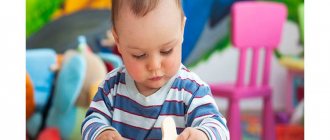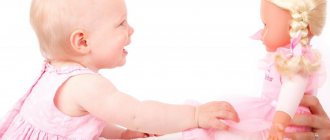Card index of didactic games for FEMP 1st junior group
Card index of didactic games for FEMP
(junior group 2017-2018 academic year)
By section: quantity
1. Didactic game “Guess who is behind whom”
Target:
to form in children the idea that some objects are obscured by others. Clarify the idea that large objects obscure smaller ones, and smaller ones do not obscure larger ones; consolidate the words “more”, “less”, “before”; introduce the word “obscure”.
Equipment.
Various toys.
Content.
The toys are on the teacher’s table. He asks you to look at what is on the table and close your eyes. He takes two toys, puts them aside a little and stands up so that he obscures them with himself. The children open their eyes and discover that two toys are missing. “I didn’t leave the table. Where did the toys go? - says the teacher. If one of the children guesses, the teacher says in surprise: “Oh, I stood up and shielded them.” If the children do not find them, then he searches for them himself and, having discovered the missing toys, explains the reason for their disappearance. After this, the teacher removes the toys and invites two children to the table: one tall, large, the other small. Children are again convinced of the principle of obscurity when the little one stands behind the back of the big one. The teacher discusses the results of the game with the children, why Tanya is not visible behind Kolya, but Kolya is visible behind Tanya: “The larger one obscures the smaller one, but the smaller one cannot obscure the larger one.”
2. Didactic game “Let’s build houses”
Target:
learn to visually correlate the size of objects and check your choice by superimposing; develop attention; consolidate words that define the relativity of quantities “more”, “less”, “same”.
Equipment.
Three cardboard houses of different sizes with slots for doors and windows, without roofs; cardboard windows, doors, roofs of three sizes, corresponding to the size of the houses.
Content.
The teacher inserts large images of three houses into the typesetting canvas, placing them in random order and not in a row. The elements of houses (roofs, windows, doors) are mixed up on the table. Then he tells the children that they will be builders, they will complete houses, which should be neat and level; All parts should be selected so that they fit the required parts. The children go around and take turns “finishing” the houses. Those sitting at the table take part in the assessment of each stage of the work. At the end, the teacher sums it up: “We installed smaller doors, a smaller roof, and smaller windows for the largest house. And the smallest house has the smallest windows, the smallest door, the smallest roof.”
3. Game "Helper"
Target:
Development of fine and gross motor skills, coordination, dexterity. Instill hard work.
Equipment:
Containers with fillers, scoops, fillers.
Content:
The teacher invites the child to transfer the contents from one container to another.
By section: size
1. Didactic game “Three squares”
Target:
teach children to correlate three objects by size and indicate their relationships with the words: “big”, small”, “medium”, largest”, “smallest”.
Equipment.
Three squares of different sizes, flannelgraph; Children have 3 squares.
Content
. Educator: Children, I have 3 squares, like these (shows). This one is the biggest, this one is smaller, and this one is the smallest (each of them shows). Now show the largest squares (children pick them up and show them), put them down. Now raise the averages. Now - the smallest ones. Next, the teacher invites the children to build towers from the squares. He shows how this is done - he places first a large, then a medium, then a small square on the flannelgraph from bottom to top. “Make such a tower on your flannelographs,” says the teacher.
2. Didactic game “Wide - Narrow”
Target:
form a “broad-narrow” view.
Content.
The lesson is carried out in a similar way, but now children learn to distinguish the width of objects, i.e. wide and narrow ribbons of the same length. When creating a game situation, you can use the following game technique. Two cardboard strips are laid out on the table - wide and narrow (of the same length). A doll and a bear can walk along a wide strip (path), but only one of them can walk along a narrow strip. Or you can play the story with two cars.
3. Didactic game “Hedgehog”
Target:
learn to correlate objects by size, to identify size as a significant feature that determines actions; consolidate the meaning of the words “big”, “small”, “more”, “less”, introduce them into the children’s active vocabulary.
Equipment.
Cardboard stencils depicting hedgehogs and umbrellas of four sizes.
Content.
The teacher says that now he will tell a fairy tale about hedgehogs: “A family of hedgehogs lived in the forest: dad, mom and two hedgehogs. One day the hedgehogs went for a walk and went out into the field. There was neither a house nor a tree there (Invites the children to find hedgehog figures on trays and put them in front of them. He approaches each one and places the figures in a row according to size). Suddenly daddy the hedgehog said: “Look how big the cloud is. It's going to rain now." “Let’s run into the forest,” suggested the hedgehog’s mother. “Let’s hide under the tree.” But then it started to rain, and the hedgehogs did not have time to hide. You guys have umbrellas. Help the hedgehogs, give them umbrellas. Just look carefully at which umbrella is suitable for whom. (See if children use the principle of comparing objects by size.) “Well done, now all the hedgehogs are hiding under umbrellas. And they thank you." The teacher asks someone why he gave one umbrella to daddy the hedgehog and another to mommy hedgehog; next child - why did he give the little hedgehogs different umbrellas? Children answer, and the teacher helps them formulate the answer correctly.
By section: form
1. Didactic game “Pick a figure”
Target:
consolidate children’s ideas about geometric shapes and practice naming them.
Equipment.
Demonstration: circle, square, triangle, cut out of cardboard, cards with outlines of 3 geometric lottos.
Content.
The teacher shows the children the figures, traces each with a finger. Gives the children a task: “You have cards on your tables with figures of different shapes on them, and the same figures on trays. Place all the figures on the cards so that they are hidden.” Asks the children to trace each figure lying on the tray, and then places (“hide”) it on the drawn figure.
2. Didactic game “Make an object”
Target:
practice composing the silhouette of an object from individual parts (geometric shapes).
Equipment.
On the teacher’s table there are large toys: a house, a tumbler, a snowman, a Christmas tree, a truck. There are sets of different geometric shapes on the floor.
Content.
The teacher offers to name the toys that are on his table and make any of them using a set of geometric shapes. Encourages and stimulates children's actions. He asks: “What did you make up? From what geometric shapes?” Children examine the resulting silhouettes of toys, remember the corresponding poems and riddles. It is possible to combine the composed silhouettes into a single plot: “House in the Forest”, “Winter Walk”, “Street”
3. Didactic game “Mailbox”
Target:
to learn to see the shape in an object, to correlate the shape of the slot and the tab, to compose a whole from different geometric shapes and their parts, selecting the ones you need through testing and trying on.
Equipment.
Boards with slots for laying out shapes, identical in color, but different in configuration, with the image of a ball, a balloon (from two semi-ovals), a two-story house (from two rectangles); figures (two semicircles of different colors, two semi-ovals of the same color, two rectangles).
Content.
Mixed boards and figures are placed in front of the child. The teacher asks the child to compose all the pictures, and then say which image he got.
4. Didactic game “Search and Find”
Target:
learn to find objects of different shapes in a room by word name; develop attention and memory.
Content.
The teacher lays out toys of different shapes in different places in the group room in advance and says: “We will look for round-shaped objects. Find everything that is round in our room and bring it to my table.” The children disperse, the teacher provides assistance to those who are having difficulty. Children bring objects, put them on the teacher’s table, sit down. The teacher examines the objects they brought with them, evaluates the result of completing the task. The game is repeated, children look for objects of a different shape.
By section: spatial orientation
1. Game “Right as Left”
Target:
mastering the ability to navigate on a sheet of paper.
Content.
The nesting dolls were in a hurry and forgot to complete their drawings. You need to finish drawing them so that one half is similar to the other. The children draw, and the adult says: “Dot, dot, two hooks, minus a comma - it’s a funny face.” And if there is a bow and a little skirt, the man is a girl. And if he has a forelock and shorts, that little man is a boy.” Children look at the drawings."
2. Didactic game “Let’s decorate the scarf”
Target:
learn to compare two equal and unequal in quantity groups of objects, practice orientation on a plane.
Equipment:
“scarves” (large for the teacher, small for the children), a set of leaves of two colors (for each child).
Content.
The teacher suggests decorating the scarves with leaves. He asks how this can be done (each child completes the task independently). Then he says: “Now let’s decorate the handkerchiefs differently, everything is the same. I will decorate my scarf, and you will decorate the little ones. Decorate the top edge with yellow leaves, like this. (Shows). Put as many leaves as I did. With your right hand, arrange them in a row from left to right. And we will decorate the bottom edge of the scarf with green leaves. Let's take as many green leaves as yellow ones. Add another yellow leaf and place it on the top edge of the scarf. Which leaves have increased in number? How can we make them equal?” After checking the work and evaluating it, the teacher suggests decorating the left and right sides of the scarf with leaves of different colors. Place as many leaves on the right side of the scarf as on the left. (Shows). In conclusion, the children decorate all sides of the scarf in their own way and talk about it.
3. Didactic game “Painting”
Target:
learn to place objects on a sheet of paper (top, bottom, sides); develop attention, imitation; consolidate the perception of holistic objects and distinguish them from each other.
Equipment.
A large sheet of paper for the panel, large applique details (sun, strip of land, house, figurine of a boy or girl, tree, bird), sheets of paper, the same small applique elements, trays, glue, tassels, oilcloths, rags according to the number of children.
Content.
The teacher tells the children that they will make a beautiful picture: he will do it on a large sheet of paper attached to the board, and they will do small ones on their own sheets of paper. You just need to watch carefully and do everything as the teacher does. Then the teacher distributes material for the application to the children. First, he sticks a strip of earth at the bottom and the sun at the top. The teacher does everything slowly, recording his actions at every moment and giving the children the opportunity to choose each element and place it correctly on paper. If necessary, helps the child determine the place on a piece of paper (top, bottom). Upon completion, the teacher compares the children’s work with his own, discussing the spatial arrangement of objects, praises them, causing a positive attitude towards the result of the work. Then he briefly describes the content of the resulting image, fixing the spatial arrangement of objects: “The boy went out into the street. I looked - the earth was below, the sky was above. The sun is in the sky. Below, on the ground, is a house and a tree. The boy is standing near the house on one side, and the tree is on the other side. A bird is sitting on a tree."
4



